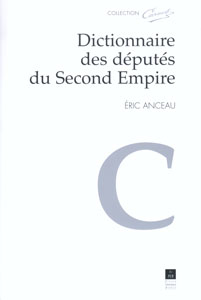History Prizes 2000
 FIRST EMPIRE PRIZE
FIRST EMPIRE PRIZE
André PALLUEL-GUILLARD, L’Aigle et la Croix. Genève et la Savoie. 1798-1815, Yens-sur-Morges (Suisse), Éditions Cabédita
Geneva and Savoy were once linked. That was during the First Empire, and both partners, whom geography had connected but whom history had separated, were to remember for many years what at the time had seemed merely an episode.
In L’Aigle et la Croix, André Palluel-Guillard provides a study of how both neighbours reacted to their similarities and differences during a difficult but fascinating period.
Napoléon Ier spent a great deal of time dealing with this region which was essential for his relations with Italy (of which he was king) and with Switzerland (of which he was Mediator of the Swiss Confederation). And after Napoleon, the whole of Europe looked closely at the future of an ensemble which had become an area fundamental for the equilibrium of Europe.
With care for the interests of both sides, André Palluel-Guillard attempts to give an even-handed treatment of the advantages and otherwise of French government in a difficult and intransigent region but nevertheless of significant strategic, economic and even tourist interest. At a moment in which both Geneva and Savoy are, independently, trying to find their position within Europe, it is right to take stock of earlier experiences, even if they ended in failure – indeed, it is never uninformative to take a hard look at the errors and imperfections of one’s predecessors.
As a study of a region during the Consulate and Empire periods, L’Aigle et la Croix is without doubt a masterpiece. But from the depth of the analysis, the accuracy and novelty of the information it possesses, it is also important as an intelligent approach to the national and international problems raised by Napoleon and his actions.
Born in Chambéry in 1940, André Palleul-Guillard is professor of contemporary history at the Université de Savoie. He is a specialist in the history of the Consulate and the Empire, having written many books and articles, notably Le Dictionnaire de l’Empereur, an analytical and thematic presentation of the correspondence and writings of Napoleon 1st (Plon, 1970), L’épisode napoléonien, Aspects extérieurs (Nouvelle Histoire de France contemporaine, Seuil, 1973, with Jacques Lovie), Grands Notables du Premier Empire: Notables du Mont-Blanc et du Léman (Dictionnaire général des notables, C.N.R.S., 1978), Histoire et dictionnaire du Consulat et de l’Empire (with J. Tulard, A. Fierro, and R. Laffont, 1995). Particularly active in the cultural life of his region, of which he one of the principal organisors, André Palluel-Guillard remains president of the Société Savoisienne d’Histoire and was the founder of the Société des Musées d’Art et d’Histoire de Chambéry. He is a member of both the Conseil d’Administration de la Société des Amis du Vieux Chambéry and the Académie de Savoie, etc., and has written innumerable pieces on the history and social and economic life of his native region.
This work, L’Aigle et la Croix, is the result of 17 years of research and is the perfect combination of two of the author’s favourite subjects, the Empire and Savoy.
 SECOND EMPIRE PRIZE
SECOND EMPIRE PRIZE
Two reference works on the Corps Législatif of the Second Empire, by Eric Anceau
Éric ANCEAU, Dictionnaire des députés du Second Empire, Rennes, Presses Universitaires de Rennes
The author presents the 613 députés who sat on the Corps législatif of the République décennale (1851-1852) and of the Second Empire (1852-1870). From Morny to Jules Ferry, from Gambetta to Thiers, the members of parliament enjoyed greatly differing destinies. This dictionary, which is part of the new interest in biography, offers not only the political and professional careers but also the family background, intellectual affinities, social life and income of the députés in question. From this work, in which the heroes of the campaigns of the First Empire rub shoulders with politically naïve business barons, great landowners, successful lawyers and also famous writers, the reader is given a very clear picture of how the socio-political elite of the whole of 19th-century France lived and worked.
Rennes : Presses Universitaires de Rennes, 2000, 421 p. (coll. Carnot)
PUR, Campus de la Harpe, 2 rue du doyen Denis-Leroy, 35044 Rennes cedex
Tél. : +33 (0)2 99 14 14 01 – Fax : +33 (0)2 99 14 14 07
Éric ANCEAU, Les députés du Second Empire. Prosopographie d’une élite du XIXe siècle, Paris, Éditions Champion
The complete version of a doctoral thesis in history defended in 1997 at the Sorbonne, this work aims to re-evaluate the role of the Second Empire Corps législatif and its députés. With its mission to approve laws and taxes for the period 1852 to 1870, this assembly was long considered as a body which simply rubberstamped proposals and whose members were either insignificant, weak or corrupt. The prosopographical technique, the detailed study of the debates and the resolutely comparative approach of the author make it possible to revise this all too hasty judgement. The authoritarian Chambre de l’Empire, whose prerogatives were very limited, was followed in the 1860s by a parliamentary assembly in the full sense of the term. It was then that the Palais-Bourbon saw some of its most memorable years, and the significant work accomplished by the members can honourably be compared with that achieved by both its predecessors and successors. Its many appendices make this book an indispensable work of reference and resource for historians of the Second Empire.
Paris : Editions Champion, 2000, 1018 p.
(coll. Bibliothèque d’histoire moderne et contemporaine, 4)
Editions Honoré Champion : vente : 7 quai Malaquais, 75006 Paris
Tél. : +33 (0)1 46 34 07 29 – Fax : +33 (0)1 46 34 64 06
